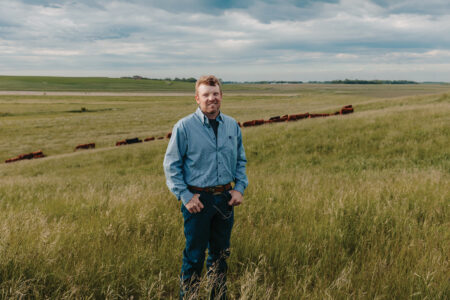Future of industry hinges on striking on right balance
The beef industry is facing challenging times with high demand and low supply — increases in price and a reduction in cattle inventory. The future though might also be challenging with a need to stay relevant but still evolve with consumer demand and money-conscious or streamlined pricing as well as maintaining supply.
The biggest factor for keeping the beef industry progressive though could lie in the usage of technology.
“There are many things technology is helping the beef industry do,” said Greg Stuefen, a local cattlemens/cow calf producer.
“From feeds and minerals that help the cattle grow…to the crops being raised to feed the cattle. In 2000, the average corn yield was 137 bushels per acre verses 2024 179 bushels per acre. And that’s just the corn. Among many other crops that are used in feeding cattle, this means we have more grain to either feed or sell. That means less acres to produce enough feed for that cow to produce year after year.”
Reasons why technology is increasingly playing a role in the future of the beef industry have to do with sustainability, animal well-being, and maximizing efficiency.
“There are many well developed technologies,” said Beef expert Andrew Coppin who has worked with cattle producers across the country. “I think we’ve spent billions of dollars working on genetics of cows, how to grow a better cow, how to run a bigger cow, how to grow more meat on a cow, and how to have less disease. But what we probably haven’t spent a lot of money on or not enough investment on is how to run a better ranch. When we’re now seeing this evolution of ranch technology or ranch tech, as it’s called in the business, that’s how I run a better ranch. The things in that realm include things like remote monitoring and sensing of water, remote control of pumps, being able to turn things on and off remotely without having to go there.”
But it’s not just the remote technology that could help advance the beef industry, it’s also AI, according to Coppin. AI can be utilized for data analysis to help recognize health trends or discern health patterns in animal health, estimating rate yields, and using robotics systems for weed control and harvest crops, and many other uses.
“Using AI cameras to identify cattle and make sure they’re healthy,” he said. “Tell me what they (cows) weigh, tell me who drank and who did not drink. There’s all these sorts of technologies that are allowing ranchers to run the ranch more efficiently, but without having to go there and without having to hire an extra person or two to get those things done. That is where they’re starting to invest material money in this remote monitoring and control of my ranch.”
While technology, Coppin says, is integral to the future of the beef industry, finding balance is also essential. Striking just the right balance can help with cost-effectiveness, collaborative governance with policymakers, and navigating the changing economic landscape.
“Governments and regulators can assist in providing a more friendly environment where the producers are more inclined to take risks,” Coppin said. “Things like rain insurance and things that allow a rancher to take more financial risk. There’s 340 million mouths to feed in this country and we need to produce beef protein as sure as we need to produce all other proteins. The population is growing, not shrinking…
The trick for regulators is to find the right balance between reducing risk and helping primary producers produce their goods without removing the need for the rancher or farmer to take on their own corporate business risk. And make good business decisions.”


